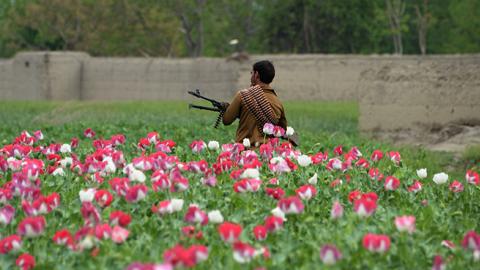Opium unifies the enemies of American interests in Afghanistan. Poppy cultivation feeds power to the Taliban, drug lords, and corrupt officials. That power grew dramatically in 2017 — up 87 percent in one year to 9,000 metric tons, according to the latest report by the U.N. Office of Drugs and Crime.
On August 21, President Donald Trump announced that U.S. policy in Afghanistan will now serve American interests without pre-established time or troop limits. “Conditions on the ground — not arbitrary timetables — will guide our strategy from now on…. We will fight to win.” However, he also noted: “Military power alone will not bring peace to Afghanistan or stop the terrorist threat arising in that country. But strategically applied force aims to create the conditions for a political process to achieve a lasting peace.”
The new policy will use force to destroy the terrorists and establish security so Afghans can “build their own nation.” That said, achieving these goals will require one thing more — eradicating opium production. According to Afghan President Ashraf Ghani, “Without drugs, this war would have been long over. The heroin is a very important driver of this war.”
Since the liberation of Afghanistan, U.S. and allied policy has failed to press the elimination of opium production as a necessary priority.
In fact, many still consider attacking opium cultivation at odds with winning the “hearts and minds” of the Afghan people, threatening the economic well-being of the subsistence farmers growing poppy. This is the deep misunderstanding that has doomed U.S. policy to failure and threatens Trump’s new effort.
The State Department reports: “Traffickers provide weapons, funding, and other material support to the insurgency in exchange for the protection of drug trade routes, cultivation fields, laboratories, and trafficking organizations…. [T]he Taliban generates revenue by taxing drugs trafficked through areas they control … the narcotics trade undermines governance and rule of law throughout the country.”
Economic data in Afghanistan is at best problematic, but few doubt that opium is the single biggest sector in terms of GDP and the portion of the labor force it captures. As a percentage of GDP, estimates of drug revenue vary from roughly a third to a half.
Opium distorts the economy to maintain the drug industry, turning resources away from building licit economic activity and diversification. Subsistence farmers are virtually forced to grow poppy and stay poor. Opium funds their oppressors and sustains the enemies of the rule of law and democratic governance. The opium economy functions as our enemies’ Marshall Plan, shaping an Afghanistan that provides sweeping power to terrorists, drug lords, and corrupt officials. An estimated 60 percent of Taliban revenue derives from the heroin trade, worth $60 billion globally.
In short, by tolerating the opium market, the United States and Afghanistan make it impossible to achieve American interests and impossible for Afghans to build something other than a state in the grip of narcoterrorists.
There is an assumption by many that the Afghan opium trade is too powerful to attack. Yet the Taliban, seeking control, virtually stopped poppy cultivation in a single year with no reports of catastrophic upheaval, or starvation. Even after the liberation, many provinces cut cultivation quickly and effectively, in response to U.S. programs; as late as 2008, 20 out of 34 Afghan provinces were poppy-free. The U.S. troop surge alone brought sufficient security and targeting of narcoterrorists to realize a decline in opium production.
The surge increased troop levels from under 30,000 in 2007 to more than 90,000 by 2012. Cultivation, having risen by U.N. estimates to nearly 200,000 hectares in 2007, fell to only 150,000 hectares by 2012. After the announcement of the pullout, troop levels subsided to only 60,000 during 2013, and poppy made a comeback.
When our forces fell to only 8,000 in 2015, the stage was set for runaway opium production. By November of 2016, the government reportedly controlled only 57 percent of Afghanistan. In the absence of U.S. troops, commitment, and control, the opium harvest is poised for explosive growth.




















